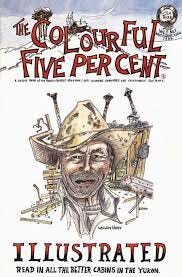Wes and Jim: "The colourful 5%."
Quick note: I'm sticking with the Canadian spelling for this particular phrase because it originated in the Great, White North.

It's not like middle school signifies the approach of the worst things into an otherwise ideal and easy life. It's just that there are many hard transitions crammed into a few years. And you and all the kids around you, fumbling over their growing limbs in gym class, are smack in the middle of these changes. Canadians call P.E. "gym" instead, and when you're a skinny, flat-chested, freckled girl, it's not the safest place. Changing clothes in front of mean girls who already had boyfriends and wore lacy bras was nightmarish for me. It sometimes felt like evil adults had masterminded the most awkward scenario possible for us and threw us in there. My strategy was to get in and out as quickly as possible. That way, I could avoid any potential conversation about tampons or French kissing, which I knew precisely zero about.
Regular class time could be just as perilous. I liked learning and tried hard to get good grades, which was extremely uncool in the 1990s. I also had glasses, which certified me as a hopeless nerd. Most teachers liked us geeky students because we actually did our homework, wanted to learn, and didn't chew tobacco in class. Not so with Mr. Sullivan, my Social Studies teacher. He was the weightlifting coach at the school, and he showered at school after the team practiced. When he wasn't leaning back in his chair with his feet on his massive desk, he would wander around the weightlifting platform he'd set up in our classroom, rolling deodorant on underneath his shirt. That wasn't even the strangest thing he did: he biked to school in the dead of winter. And in the Yukon, that means -40-degree temperatures. I'd see him from the school bus window, nearly mummified in his winter layers, pedaling through the roadside sludge. Of course, this behavior made us extremely suspect of him and anything he tried to teach us.
He seemed to revel in making us feel even more awkward than we already did: he singled me and my friend Melissa S. out for being glaringly obvious geeks. He would entertain the rest of the class with stories of our criminal escapades as biker gang members. He knew we'd spent the weekend doing our French homework and reading Little House on the Prairie while our classmates had experimented with marijuana and gotten drunk in their parent's basements. But nobody, including teachers, was bludgeoning kids with the moral imperative of spreading kindness back in 1993. Nope, teachers like Wes Sullivan were paid to inflict misery on us for 60 minutes a day.
Mr. Sullivan wasn't a typical guy. He kept and ran sled dogs as a hobby. He lived on a piece of land in what we call "the bush," which means you don't live "in town" on a street with a green sign, surrounded by other houses, roads, and sidewalks. The other thing about living in the bush is that the people who live out there typically prefer having wild animals for neighbors. They don't want to make small talk or worry about whether anyone likes the paint color they chose or whether their front lawn is a graveyard for rusty cars. In the Yukon, some characters are known as the "colourful 5%". They're people who carry stories around with them. Stories that might be better described as legends because you can't be sure whether they're true.
I've always accepted this story as truth, probably because it explains why I feared Mr. Sullivan. The first thing you need to understand in this story is that the ground is permanently frozen in the Yukon, below the most superficial layer of dirt. This permafrost makes it hard to do things in the winter, like digging basements or graves for dead people—or dead animals. Well, one of Mr. Sullivan's beloved sled dogs died one winter, and because he couldn't dig a hole deep enough to bury it, he let that dog get good and frozen. Dead bodies don't stink or decay when they're frozen. So, he put that furry icicle of a dog in the bed of his pickup truck and drove it all over town all winter. The next time you find a petrified french fry under your seat in our van, remember that things could be much worse.
Another "colourful" character who hung around was Jim Dillabough. He lived in a mobile home on the straight stretch of road leading north to Dawson City and its creek beds dredged for gold. Jim was notorious in Whitehorse. He had threatened and shot at people walking on his land, killed one of his neighbor's horses, and nearly starved the ones he kept on his land, which he advertised as an R.V. park, hoping that unsuspecting American tourists might pay him a couple of bucks for a patch of dirt. Everyone called him "Crazy Jim". I knew he was crazy because I couldn't look him in the eyes. They were shining and wild, never resting anywhere. Seeing his faded yellow Toyota rattling down our gravel road caused my skin to crawl and my stomach to lurch. Thankfully, he never showed up at my school to teach home economics.
Thanks for reading today, friends.


